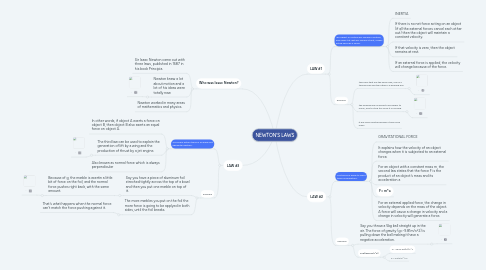
1. Who was Isaac Newton?
1.1. Sir Isaac Newton came out with three laws, published in 1687 in his book Principia.
1.2. Newton knew a lot about motion and a lot of his ideas were totally new
1.2.1. .
1.3. Newton worked in many areas of mathematics and physics.
2. LAW #1
2.1. "An object in motion will remain in motion, and object at rest will remain at rest, unless acted upon by a force"
2.1.1. INERTIA
2.1.2. If there is no net force acting on an object (if all the external forces cancel each other out) then the object will maintain a constant velocity.
2.1.3. If that velocity is zero, then the object remains at rest.
2.1.4. If an external force is applied, the velocity will change because of the force.
2.2. Example
2.2.1. two balls that are the same size, one is a tennnis ball and the other is a bowling ball.
2.2.1.1. .
2.2.2. the bowling ball is going to be harder to move, and to stop too once it is moving.
2.2.2.1. .
2.2.3. it has more inertia because it has more mass.
3. LAW #3
3.1. "For every action there is an equal but opposite reaction"
3.1.1. In other words, if object A exerts a force on object B, then object B also exerts an equal force on object A.
3.1.2. The third law can be used to explain the generation of lift by a wing and the production of thrust by a jet engine.
3.1.2.1. .
3.1.3. Also known as normal force which is always perpendicular
3.2. Example
3.2.1. Say you have a piece of aluminum foil streched tightly across the top of a bowl and then you put one marble on top of it.
3.2.1.1. Because of g, the marble is exertin a little bit of force on the foil, and the normal force pushes right back, with the same amount.
3.2.1.1.1. .
3.2.2. The more marbles you put on the foil the more force is going to be applyed in both sides, until the foil breaks.
3.2.2.1. That's what happens when the normal force can't match the force pushing against it.
4. LAW #2
4.1. "Net force is equal to mass times acceleration"
4.1.1. GRAVITATIONAL FORCE
4.1.2. It explains how the velocity of an object changes when it is subjected to an external force.
4.1.3. For an object with a constant mass m, the second law states that the force F is the product of an object's mass and its acceleration a
4.1.4. F= m*a
4.1.5. For an external applied force, the change in velocity depends on the mass of the object. A force will cause a change in velocity and a change in velocity will generate a force.
4.2. Example
4.2.1. Say you throw a 5kg ball straight up in the air. The force of gravity (g=-9.81m/s^2) is pulling down the ball making it have a negative acceleration.
4.2.1.1. .
4.2.2. F=5(9.81 m/s^2)
4.2.2.1. F= 49.05 kg(m)/s^2
4.2.2.2. F= 4.91x10^1 N
